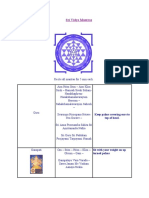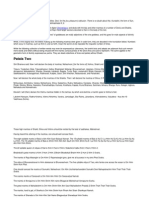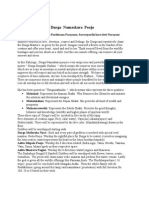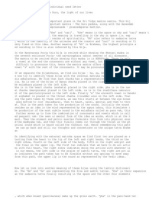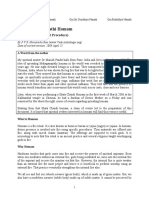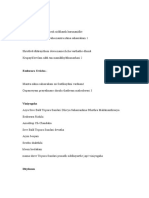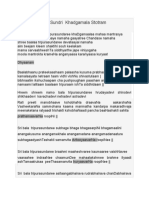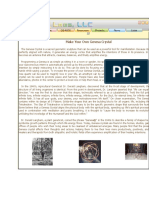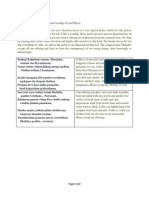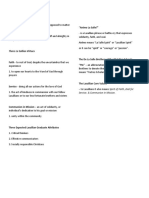Essence of Mantra
Essence of Mantra
Uploaded by
stephen2kinCopyright:
Available Formats
Essence of Mantra
Essence of Mantra
Uploaded by
stephen2kinCopyright
Available Formats
Share this document
Did you find this document useful?
Is this content inappropriate?
Copyright:
Available Formats
Essence of Mantra
Essence of Mantra
Uploaded by
stephen2kinCopyright:
Available Formats
The Essence of Mantras Since ancient time till the present era; Mantras have been used as a remedy
for nearly every problem. With the increasing number of TV channels in India, the si tuation is such that you tell about any issue and one out of ten persons, you wi ll find at least one to come out with a handy Mantra to resolve your issue. The great learned pundits are there on the small screen almost round the clock. Now a question arises, do we really get benefit from those free of cost advice ? I d on't think the TV channels will be helpful to you in this respect. They should b e more than happy with the increasing TRP and would haradly get time to undertak e a survey to find effacasy of such remedial mantras etc. With a view to verify the effectiveness of mantras, let us try to answer these q uestions :* Can one mantra be effective for multiple purposes ? * What is the source of power of any mantra ? * What is the correct way of using a mantra ? * What matters the most - The sound, the tone and rhythm of reciting a mantr a, the meaning of the words used in the mantra, or the procedure prescribed? * By usage of a Mantra can any one be able to escape from experiencing the f ructification of Karma? * How does 'offering' of a mantra by a Siddha makes a difference? One Mantra removes all evil : One should not need any thing more than mere common sense to reject the notion o f 'elixir' kind of a Mantra that can be used to resolve a problem irrespective o f nature of problem. As we accept the low of 'Cause and Effect'; we have to find the likely cause of a problem and then the remedy has to address the cause. In a way, the remedy sho uld be a kind of reversal process of the cause. We can understand that every problem has to have a particularly related cause an d hence, it has to be addressed with a specific process. Thus, a Mantra to incre ase physical height of a person cannot be accepted as a cure of Cancer. Hindu mantras like 'Maha Mrintyunjaya Mantra', 'Gayatri Mantra', etc. suffer fro m the notion of 'One-for-All' remedy and we most humbly do not agree with the be lief. The sanctity of mantras for spiritual upliftment should be maintained and must n ot be recommended for temporal laukik reasons as trival as 'securing a job trans fer ' or 'begetting children' etc. People indulging in such activities are unkno wingly doing a grave disservice to the sacred heritage of Vedas. Prerequisites for Using a Mantra : The seers who formulated the mantras offered them to their disciples who were we ll-versed with the prerequisites as a part of the methodology of particular scho ol of spiritual Sadhana. The knowledge of such prerequisites was believed to be so fundamental that its narration, at times, used to be ommitted to avoid repeti tion. Most of the mantras have been a part of a Stotra or an Upanishad or a fullfleged Sadhana or an Anushthana and were never intended to be used in isolation. Howev er, over a period of time, some of the Pundits started compiling the mantras and formulated books of such collection. At this stage, the brevity was the call an d not only the prerequisites, but even the overall purpose and relevance lost th eir place. In the modern age, where education and spirituality has turned into an Industry,
Astrology, too, has slipped into the hands of commercial people. In absence of honest custodians and the rightful inheritors; mantras are prescribed in most bi zzare manner by the commecial astrologers for meeting their selfish means. Needl ess to say, mantras have become tools in their hands to exploit the greedy and i gnorant people. The Rishis who formulated the mantras also advocated certain procedures to be fo llowed for its right use. This include a formal commitment in the form of 'Sanka lpa', some movements and gestures in form of 'Nyasa', creating protective sheath in form of 'Kavacha' and offerings to the Devata in the form of 'Arghya'. Let us understand the procedure (Vineeyoga) as well as the parts of mantra. Sankalpa : Sankalpa with respect to Mantra Sadhana, means a formal committment about one's plan of the Sadhana. A statement of sankalpa generally contains one's own identi fication. This is in the vedic manner including one's full name, one's vedic lin eage i.e. Veda, Gotra, Shakha etc. Then follows ones desire to chant the Mantra for a particular duration and in particular number or undertake an Anushthana fo r fulfilment of a particular wish. The sankalpa is addressed to the Devata of th e Mantra. Ritualistically, a sankalpa is taken through Sanskrit. However, as we know the significance of Mental vibrations in Mantra Sadhana, it should be OK to undertake the Sankalpa in one's own language. Nyasa : Nyasa is an important preperatory stage of Mantra Sadhana. It is in a way a 'war ming up' and 'cleansing' session prior to undertaking Mantra chanting. There are different types of Nayasa, e.g.Anga Nyasa, Kara Nyasa, Rishyadi Nyasa, Hridayad i Nyasa, Panchatatwa Nyasa, Varna Nyasa etc. pembody himself for the Mantra he i s chanting. This is what called as Nyasa. For that purpose, Though each one has it's special benefits, Rishyadi Nyasa is famous. Kavacha : Kavacha' is the imagery sheild to be created for the protection of the Sadhaka d uring Sadhana. It is very important because, the Sadhaka loses his conscious sen se of awareness as he transgress into meditative state or altered state of aware ness. During such a state he stands vulnerable and exposed to abnormal frequenci es and vibrations. The performing of Kavacha protects the Sadhaka from such vibr ations. The Kavacha in a way create hypontic layer of self-confidence and keep h im comfortable Arghya : In addition to the procedure, it is vital to understand the essential parts of a Mantra. Every mantra is suppose to be complete only when it is used with the f ollowing six parts, knows as 'Shadanga': * * * * * * Rishi Chhandas Devata Beeja Keelaka and Shakti.
Rishi : Rishi is the person who originally formulated the Mantra. In vedic culture, Rish i is believed as the seer, a visualizer of Mantra. The prerequisite of naming th e Rishi of the mantra before using the same is a humble way of showing gratitude and acknowledgement. This act of acknowledgement is the first step towards delu tion of personal pride and ego. The feeling of gratitude initiates the altered s
tate of mind leading to internal environment congenial to invocation of the Deva ta of the Mantra. Chhandas : Chhandas denotes to the gramatical formation of words in a particular rhythm. The chhanda sets the pattern of words and number of syllables. The form ation guides the recitation of the Mantra in a particular way. The pattern activ ates different points in human brain and further augment the internal psychic en vironment. Each chhanda has its own attributes to influence the mood of the pers on reciting it. Chhandas are classified into two types (1) Varnik Chhand (alphabetical stanzas) and (2)Matrik Chhand (stanzas containing short vowels). Hindu mantras follow the Chhandas of their respective Vedic Samhita and Shakha. Generally a distinct Mat rik Chhanda has been preferred by different Shakha in different Samhitas. Devata : Devata of the Mantra is the form of the god who is being propitiated. The deveta element engages the visualizing faculty of human mind. Every Devata has its own Shape, Colour, Posture, Gesture, Mudra, Ayudha, and personality. The preceding steps of Rishi and Chhanda prepares the ground for effective visualization of th e Devata. The initial utterrance of name of the Devata creates flashes of the vi sions. Its frequent repetition enables a devotee to contemplate upon the form of the Devata. Ultimately, he forgets his own self and gets unified with the form of the Devata. Beeja : Beeja is a single letter of Sanskrit Alphabet and it represent, again, shortes p ossible form of the Devata. The shape of the Beeja creates the route for the ene rgy to vibrate. Beejam resembles the basic character (tatva) of the mantra. for example jala tatva(soft), agni tatva (hard) etc. Keelaka : Keelaka means a nail. Now, what is significance of a Nail here with respect to r eciting a Mantra ? To understand the significance of Keelaka we have to link it with the nail that stops a rotating wheel slipping out of its excel. We know tha t the energy of a mantra is generated from the mind of the person and its import ant to keep it centered at a point to save it getting dissipated. This is done t hrough Keelaka. Some people symbolize it with a key of the lock. Thus, a keelaka is believed to be a Key to open the lock of the source of a Mantra power. Shakti : Shakti means Power. Shakti means power or energy of the Mantra. This is the powe r generated through reciting the mantra. It has to be noted that every Mantra has its own form of Shakti. However, let us admit that today, except the name denoted to the Shakti, we do not know much ab out distinct forms of the energy of Mantra. The main reason for this ommission i s attributable to the fact that graphical reproduction of the form of energy vib rations visualized during altered state of mind remains difficult. The second re ason for the misconception is that we consider the words 'Devi' and 'Shakti' as synomniums. Due to this ambiguity, it is quite possible that a Sadhaka of a Mantra may conte mplate upon a known form of Devi in stead of the energy vibrations of the Mantra . Now, it should be clear as to why we don't get the much acclaimed results from r eciting a mantra. If we ignore the essential 6 parts, how can we expect the desi red effects?
The limitation lies on two parts. First is the ignorance of the doer. The person who undertakes Mantra, does not know the essential pre-requisites. Secondly, th e limitation lies with the source from where a person receives the mantra. It is quite common now that people take mantra from any source, be it a cheap pocket book being sold at the roadside, any Sadhu or a TV Jyotishi. It is quite possibl e that the pre-requisites are compromised in offering and receiving the Mantra i n this manner.
You might also like
- Thomas Merton New Seeds of ContemplationDocument313 pagesThomas Merton New Seeds of Contemplationnis_octav703797% (36)
- Unveiling Potential: A Guided Journey to Discover Your Hidden TalentsFrom EverandUnveiling Potential: A Guided Journey to Discover Your Hidden TalentsNo ratings yet
- Holy Biographies of The Five Founding Masters of The Sakya OrderDocument61 pagesHoly Biographies of The Five Founding Masters of The Sakya OrderThubten KönchogNo ratings yet
- Chakra HandoutDocument2 pagesChakra Handoutmecardxviii100% (13)
- Aksha Mala Bindu BhedanamDocument21 pagesAksha Mala Bindu BhedanamNaresh Muttavarapu100% (1)
- Sri Skanda Jyothi Vidhana Shodasa Upachara PujaDocument45 pagesSri Skanda Jyothi Vidhana Shodasa Upachara Pujadivyaunsh dand100% (1)
- Names For The GoswamiDocument12 pagesNames For The GoswamivivekgiriNo ratings yet
- 12 Chakra SystemDocument9 pages12 Chakra Systemagnes100% (2)
- Yoga Teachers Training ManualDocument649 pagesYoga Teachers Training Manualrahul1nayan100% (31)
- Tantra of the Srikula Part I The secret of the Dark Goddess NikumbhilaFrom EverandTantra of the Srikula Part I The secret of the Dark Goddess NikumbhilaNo ratings yet
- Mat RikaDocument5 pagesMat RikaSrikanth Sri Vatsa KaturiNo ratings yet
- SV PointersDocument4 pagesSV PointersAnonymous lfw4mfCmNo ratings yet
- Navarathri Malar 1994 1Document13 pagesNavarathri Malar 1994 1SaravanapriyanSriraman100% (3)
- Sri Vidya Mantras: Keep Palms Covering Ears To Top of HeadDocument4 pagesSri Vidya Mantras: Keep Palms Covering Ears To Top of HeadmusiboyinaNo ratings yet
- 2010 Blossom 14 Petal 4Document18 pages2010 Blossom 14 Petal 4egauthamNo ratings yet
- Devirahasya IIDocument3 pagesDevirahasya IIpriteshbamania100% (1)
- Bala Mukthavali StotramDocument1 pageBala Mukthavali StotramrambhaktaNo ratings yet
- Durga NamaskaraDocument2 pagesDurga NamaskaraxytiseNo ratings yet
- Shani Amavasya in Year 2016Document32 pagesShani Amavasya in Year 2016vinulalNo ratings yet
- Shree Vidya Online Course Registration Details3Document3 pagesShree Vidya Online Course Registration Details3dreamwebworldNo ratings yet
- Deepa DeviDocument2 pagesDeepa DeviKutticad RameshNo ratings yet
- Surya Ashtakam - Vedanta Spiritual LibraryDocument48 pagesSurya Ashtakam - Vedanta Spiritual Librarybedanta04No ratings yet
- AnandalahariDocument5 pagesAnandalahariGyanaRaghavan-chamuNo ratings yet
- Sri Vidyaranyokta Panchadasi Yukta Bija Samputita Srisukta VidhanamDocument19 pagesSri Vidyaranyokta Panchadasi Yukta Bija Samputita Srisukta VidhanamlokalalithaambikayantrasNo ratings yet
- UntitledDocument2 pagesUntitledKutticad Ramesh100% (1)
- Devi Rahasya MantrasDocument1 pageDevi Rahasya MantrasMadgaon ModakNo ratings yet
- List of 51 Shakti Peetha of Goddess DurgaDocument5 pagesList of 51 Shakti Peetha of Goddess DurgapankajsarmiNo ratings yet
- Laghaya Navāvara A PūjāDocument33 pagesLaghaya Navāvara A PūjānavinnaithaniNo ratings yet
- Sri Prathyangira Siddhi Lakshmi StotramDocument36 pagesSri Prathyangira Siddhi Lakshmi StotramSHAILESH PURANIK0% (1)
- Armour of Shri Bala TripurasundariDocument2 pagesArmour of Shri Bala TripurasundariKumar Makana100% (1)
- Saiva Siddhanta Tatva Prakasam CatechismDocument13 pagesSaiva Siddhanta Tatva Prakasam CatechismSivasonNo ratings yet
- PanchadasiDocument3 pagesPanchadasinvish730% (1)
- Maha Ganapati HomamDocument36 pagesMaha Ganapati Homambuddy261100% (1)
- Bala Sahasranamam EnglishDocument17 pagesBala Sahasranamam EnglishAsha Manoharan50% (2)
- Sri Bala Tripurasundari Khadgamala Stotram FinalDocument3 pagesSri Bala Tripurasundari Khadgamala Stotram FinalSHIV RAMNo ratings yet
- Lalita Trishati Stotra LyricsDocument4 pagesLalita Trishati Stotra LyricsArathy A KNo ratings yet
- Devi Vaibhava Ashcharya Ashtottara Shata Divyanama StotramDocument7 pagesDevi Vaibhava Ashcharya Ashtottara Shata Divyanama StotramAnanda NathaNo ratings yet
- Aakash BhairavDocument1 pageAakash BhairavSarin ShahiNo ratings yet
- Vaikrtika Rahasya - The Mystery of The TransformationsDocument7 pagesVaikrtika Rahasya - The Mystery of The TransformationsRamesh RajagopalanNo ratings yet
- Sri Chakra and The Body PDFDocument3 pagesSri Chakra and The Body PDFizzybjNo ratings yet
- Lalitha SahasranamamDocument20 pagesLalitha Sahasranamambhavani_sureshNo ratings yet
- Daily Nitya Puja-What When HowDocument2 pagesDaily Nitya Puja-What When HowargiesNo ratings yet
- Lalitha Sahasranamam and MeaningDocument43 pagesLalitha Sahasranamam and MeaningAdi SuciptaNo ratings yet
- 16 GaneshsDocument5 pages16 GaneshsNagesh KumaraswamyNo ratings yet
- Shri 52 Shaktipeeth :location, Shakti Peeth Name, Bahirav Name and Organ Description of 52 ShaktiDocument9 pagesShri 52 Shaktipeeth :location, Shakti Peeth Name, Bahirav Name and Organ Description of 52 ShaktiPooja ChandramouliNo ratings yet
- All HBV Gopal Mantra NyasasDocument120 pagesAll HBV Gopal Mantra NyasasGaura KeshavaNo ratings yet
- Yoga VaibhavamDocument16 pagesYoga VaibhavamAnilkumar Shankarbhat NagarakattiNo ratings yet
- Nabhi Vidya - IntroductionDocument14 pagesNabhi Vidya - IntroductionJacob HoyNo ratings yet
- Śrī Devī Kha GamālārcanamDocument8 pagesŚrī Devī Kha GamālārcanamnjaykumarNo ratings yet
- Shrvidya ConferenceDocument2 pagesShrvidya ConferencePrathap Vimarsha100% (1)
- Shakthi Mahimna StotramDocument18 pagesShakthi Mahimna StotramRavindra Shinde100% (2)
- Sri Chakra Rahasyam Part2Document6 pagesSri Chakra Rahasyam Part2Pramod DevalNo ratings yet
- Chanting RulesDocument4 pagesChanting RulesLavanya YarlagaddaNo ratings yet
- 08 Chapter 2 & 3Document52 pages08 Chapter 2 & 3samm123456No ratings yet
- NavaShakti Upasana in Vishnu PDFDocument4 pagesNavaShakti Upasana in Vishnu PDFloose manusyaNo ratings yet
- Guru ShishyaDocument9 pagesGuru ShishyaShuba Lakshmi100% (1)
- Bhairava Dashanama Stotra : Ten Names of Bhairava to Overcome Pain and SufferingFrom EverandBhairava Dashanama Stotra : Ten Names of Bhairava to Overcome Pain and SufferingNo ratings yet
- High Frequency StonesDocument4 pagesHigh Frequency Stoneskeepfloppingaces100% (1)
- LM 3 LP 5 Local History and Indigenous People 03 August 2021Document8 pagesLM 3 LP 5 Local History and Indigenous People 03 August 2021Carlos DavidNo ratings yet
- N - Selected BibliographyDocument9 pagesN - Selected Bibliographyhomospin20140% (1)
- Cyprus Map - Historic PlacesDocument2 pagesCyprus Map - Historic PlacesT.e. Cat100% (1)
- The Meditation On Twin Hearts by Master Choa Kok Sui 6Document21 pagesThe Meditation On Twin Hearts by Master Choa Kok Sui 6selvi_sapnaNo ratings yet
- The Glories of Mary - Saint Alphonsus LiguoriDocument319 pagesThe Glories of Mary - Saint Alphonsus LiguoriDennis KlinemanNo ratings yet
- Meditation - Crash CourseDocument14 pagesMeditation - Crash CourseSudhakar V.Rao MD100% (2)
- Ātma Jnāna - Melting Into BeingDocument10 pagesĀtma Jnāna - Melting Into BeingJeldsNo ratings yet
- BG Chapter 5Document32 pagesBG Chapter 5gaurnityanandaNo ratings yet
- Collegeprayer 1 PDFDocument4 pagesCollegeprayer 1 PDFbalajisugunaNo ratings yet
- Teachings of The Sanctuary of ThothDocument271 pagesTeachings of The Sanctuary of ThothPedro Marcelo100% (1)
- Approaches To Liberation and Synthesis: December 26, 2016Document15 pagesApproaches To Liberation and Synthesis: December 26, 2016akshay patriNo ratings yet
- Lectio Divina BookletDocument2 pagesLectio Divina BookletRaphael888No ratings yet
- Jung and Postmodern TheologyDocument5 pagesJung and Postmodern TheologyDaniel Lee Eisenberg JacobsNo ratings yet
- AdvancedLesson20, Psychiana, FrankRobinson PDFDocument12 pagesAdvancedLesson20, Psychiana, FrankRobinson PDFArthur100% (1)
- On DadajiDocument22 pagesOn DadajiAmiya Roy Choudhury DadajiNo ratings yet
- Project 1Document4 pagesProject 1Swami AbhayanandNo ratings yet
- YidamDocument2 pagesYidamOliviu BraicauNo ratings yet
- Concise Sadhana of Vajrapani Hayagriva King GarudaDocument4 pagesConcise Sadhana of Vajrapani Hayagriva King GarudaHendy100% (1)
- IRS3E Module 1-5E Method (Introduction To Religion, Religious Experiences and Spirituality) - 1Document41 pagesIRS3E Module 1-5E Method (Introduction To Religion, Religious Experiences and Spirituality) - 1Zaiden John RoquioNo ratings yet
- Shiva ManasaDocument2 pagesShiva ManasaManesh DumdeNo ratings yet
- S 0038713411003861 ADocument33 pagesS 0038713411003861 AWa RioNo ratings yet
- Lasallian Spirituality: Animo Means "La Salle Spirit" or "Lasallian Spirit"Document2 pagesLasallian Spirituality: Animo Means "La Salle Spirit" or "Lasallian Spirit"Michael John PedrajasNo ratings yet
- Money Magick Frater UdDocument226 pagesMoney Magick Frater UdRicardo Lino82% (17)
- New Age: Mind, Body and Spirit OnenessDocument17 pagesNew Age: Mind, Body and Spirit OnenessknowHOWNo ratings yet













